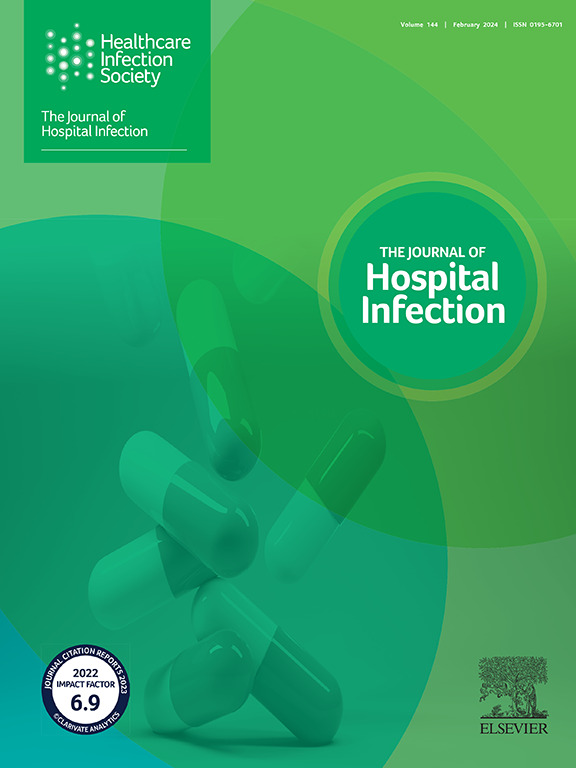心胸移植人群中分枝杆菌脓肿的爆发与缓解:自来水的问题。
IF 3.9
3区 医学
Q1 INFECTIOUS DISEASES
引用次数: 0
摘要
背景:目的:描述疫情调查和缓解措施,以应对心胸移植住院患者中医源性脓肿分支杆菌病例的增加:我们从电子病历中提取了脓肿分枝杆菌爆发前(2018 年 3 月至 2020 年 12 月)和爆发期间(2021 年 1 月至 2022 年 6 月)患者的临床特征。一个多学科团队对疫情进行了调查,并制定了在本机构实施的缓解策略:脓毒症基线发病率为每万个患者日0.11例,疫情爆发期间增至每万个患者日0.24例。疫情爆发前,1/9(11%)名心胸移植患者感染了脓毒性霉菌,而疫情爆发期间,7/12(58%)名心胸移植患者感染了脓毒性霉菌;疫情爆发前,6/9(67%)名呼吸道标本类型患者感染了脓毒性霉菌,而疫情爆发期间,10/12(83%)名呼吸道标本类型患者感染了脓毒性霉菌。在涉及水的临床护理活动中,使用了各种水源,包括过滤水和自来水。在实施无菌水预防措施的疫情缓解策略后,与医疗保健相关的脓毒症霉菌发病率降至每万个患者日 0.06 例:结论:多学科团队就杜绝接触自来水开展了强有力的教育工作,是降低本机构医源性脓毒症发病率的有效措施。对于面临类似问题的其他肺移植中心来说,NTM 感染监测、有针对性的教育和用水防护策略可能是有益的预防策略。本文章由计算机程序翻译,如有差异,请以英文原文为准。
Mycobacteroides abscessus outbreak and mitigation in a cardiothoracic transplant population: the problem with tap water
Background
Hospital outbreaks caused by Mycobacteroides abscessus complex are a major cause for concern in vulnerable patients such as the cardiothoracic transplant population.
Aim
To describe the outbreak investigation and mitigation steps undertaken to address an increase in healthcare-associated M. abscessus complex cases in an inpatient cardiothoracic transplant population.
Methods
We extracted clinical characteristics from patients with M. abscessus pre-outbreak (March 2018 to December 2020) and during the outbreak (January 2021 to June 2022) from the electronic medical record. A multi-disciplinary team conducted the outbreak investigation and devised a mitigation strategy to implement at our institution.
Findings
The baseline incidence of healthcare-associated M. abscessus was 0.11 cases per 10,000 patient-days; this increased to 0.24 cases per 10,000 patient-days during the outbreak. There were 1/9 (11%) cardiothoracic transplant patients in the pre-outbreak group compared with 7/12 (58%) during the outbreak, and respiratory specimen types compromised 6/9 (67%) of M. abscessus results in the pre-outbreak group compared with 10/12 (83%) during the outbreak. Among the clinical care activities involving water, a variety of water sources were utilized, including filtered and tap water. The incidence of healthcare-associated M. abscessus subsequently decreased to 0.06 cases per 10,000 patient-days after implementing an outbreak-mitigation strategy of sterile water precautions.
Conclusions
Robust educational efforts from a multi-disciplinary team on eliminating exposure to tap water were effective measures to reduce healthcare-associated M. abscessus incidence at our institution. Non-tuberculous mycobacteria infection surveillance, targeted education, and water mitigation strategies may be beneficial preventative strategies for other lung transplant centres facing similar issues.
求助全文
通过发布文献求助,成功后即可免费获取论文全文。
去求助
来源期刊

Journal of Hospital Infection
医学-传染病学
CiteScore
12.70
自引率
5.80%
发文量
271
审稿时长
19 days
期刊介绍:
The Journal of Hospital Infection is the editorially independent scientific publication of the Healthcare Infection Society. The aim of the Journal is to publish high quality research and information relating to infection prevention and control that is relevant to an international audience.
The Journal welcomes submissions that relate to all aspects of infection prevention and control in healthcare settings. This includes submissions that:
provide new insight into the epidemiology, surveillance, or prevention and control of healthcare-associated infections and antimicrobial resistance in healthcare settings;
provide new insight into cleaning, disinfection and decontamination;
provide new insight into the design of healthcare premises;
describe novel aspects of outbreaks of infection;
throw light on techniques for effective antimicrobial stewardship;
describe novel techniques (laboratory-based or point of care) for the detection of infection or antimicrobial resistance in the healthcare setting, particularly if these can be used to facilitate infection prevention and control;
improve understanding of the motivations of safe healthcare behaviour, or describe techniques for achieving behavioural and cultural change;
improve understanding of the use of IT systems in infection surveillance and prevention and control.
 求助内容:
求助内容: 应助结果提醒方式:
应助结果提醒方式:


